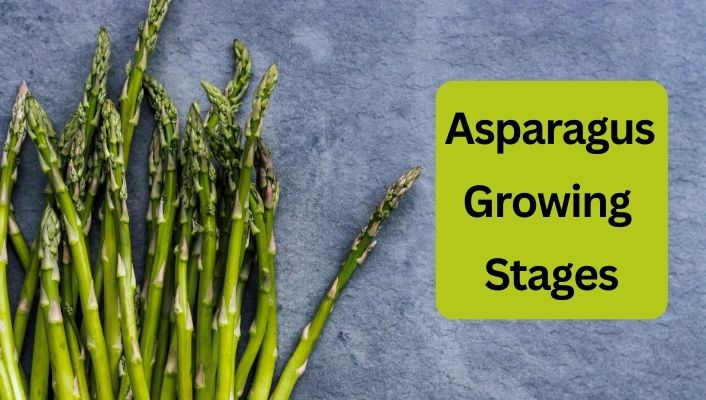Welcome to the wonderful world of growing asparagus! Understanding the different Asparagus growing stages is vital for a bountiful harvest. From the moment the seeds sprout to the time of picking, each stage plays a crucial part in the plant’s overall development.
Our article will take you through the various stages of growing asparagus. Learn valuable insights along the way and get ready to explore the fascinating cultivation process.
Post Contents
Quick Overview of Asparagus:
This simple table provides basic information about asparagus, a popular vegetable known for its delicate flavor and versatility.
| Aspect | Description |
|---|---|
| Botanical Name | Asparagus officinalis |
| Family | Asparagaceae |
| Plant Type | Perennial vegetable |
| Edible Part | Young shoots or spears |
| Flavor | Delicate and slightly sweet |
| Nutritional Value | Low in calories, high in fiber, folate, vitamins A, C, E, and K, as well as minerals like iron |
| Growing Season | Spring to early summer for harvesting; continues to grow throughout the summer |
| Planting Method | Crown division or seed propagation |
| Average Height | Up to 4-6 feet (1.2-1.8 meters) |
| Lifespan | 10-15 years or more when properly cared for |
| Preferred Climate | Temperate regions |
| Cold Hardiness | Most varieties can withstand frost and temperatures down to 20°F (-6°C) |
| Watering Needs | Consistent moisture but avoid overwatering |
| Sunlight Requirement | Full sun (6-8 hours of direct sunlight per day) |
| Soil Preference | Well-drained, fertile soil with a pH level between 6.0 and 7.0 |
| Harvesting Time | Begins in the third year of growth; harvest spears when they reach 6-8 inches (15-20 cm) tall |
The 7 Asparagus Growing Stages:
When it comes to growing asparagus, there are seven important stages of growth. Each stage has its own role in shaping the plant’s development, from seed to harvest.
Let’s explore these seven stages and learn about the journey of asparagus growth.
1. Germination
The first stage in asparagus growth is germination. It all begins with high-quality asparagus seeds. These seeds require specific conditions to sprout successfully. Moisture, warmth, and well-drained soil are vital for germination.
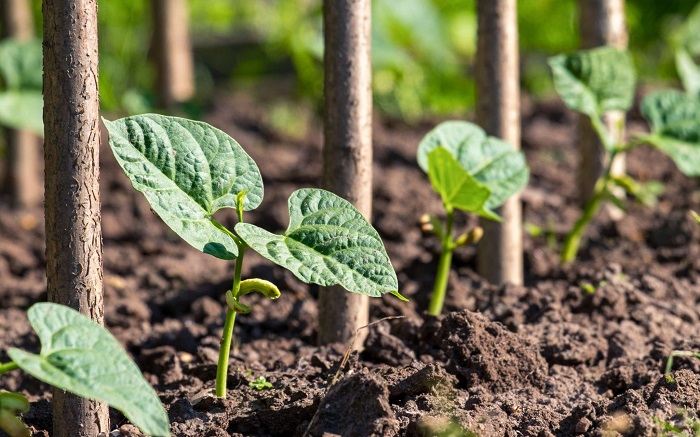
Once the seeds are sown, they undergo a process where the embryo inside the seed awakens, and a small shoot emerges from the ground. This tiny shoot marks the beginning of the asparagus plant’s life.
2. Seedling Stage
After germination, the asparagus enters the seedling stage. During this phase, the plant focuses on developing a strong root system and establishing its above-ground growth. The seedling stage is crucial for the plant’s overall health and vigor.
Adequate sunlight, water, and nutrients are essential to ensure healthy growth during this period. It is important to protect the young seedlings from pests and diseases and provide them with a suitable environment to thrive.
Related: 5 Bell Pepper Growing Stages! [An Ultimate Guide]
3. Crown Establishment
As the asparagus plants mature, they enter the crown establishment stage. At this point, the plant begins to form a crown, which is a mass of rhizomes or underground stems. The crown is responsible for producing spears in the following growing seasons.
It takes time for the crown to develop fully, usually around two to three years. During this stage, it is crucial to provide the plants with proper care and maintenance, including regular watering, fertilization, and weed control.
4. Vegetative Growth
After the crown establishment, the asparagus plants enter the vegetative growth stage. This stage is characterized by the emergence of spear-like shoots from the crown.
These shoots rapidly grow into fern-like foliage that captures sunlight and converts it into energy through photosynthesis. It is essential to maintain a healthy balance of nutrients, water, and sunlight during this phase to ensure robust vegetative growth.
5. Fern Growth
Once the vegetative growth stage is complete, the asparagus plants transition into the fern growth stage. During this period, the foliage expands and reaches its maximum height. The ferns play a crucial role in storing energy reserves in the crown for the next growing season.
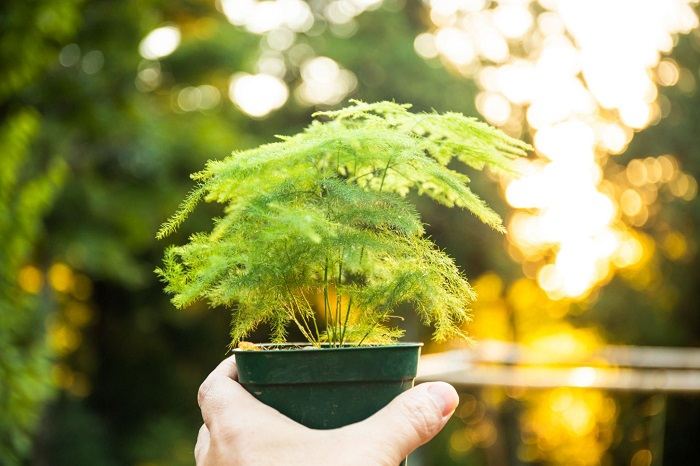
The plants continue to photosynthesize and build up strength during this stage. Pruning and maintaining the ferns are essential to prevent overcrowding and promote air circulation.
6. Harvesting Stage
After years of nurturing, the asparagus plants finally reach the highly anticipated harvesting stage. This is when the spears are ready to be harvested. The timing of the harvest is crucial, as it ensures the asparagus spears are tender and flavorful.
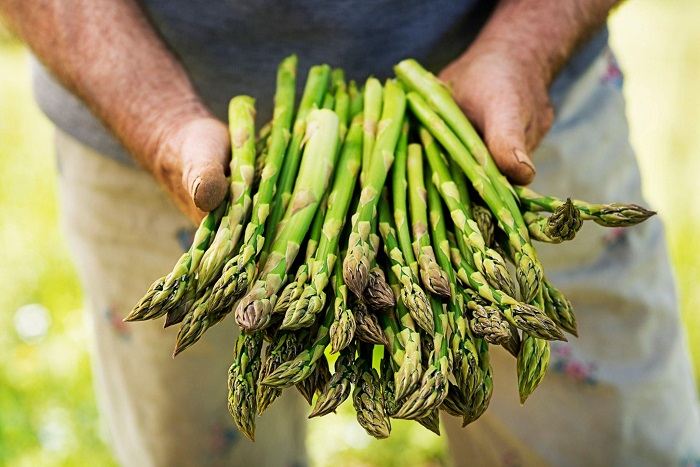
Careful selection and cutting techniques are necessary to ensure a bountiful harvest while leaving the plants undamaged. Regular harvesting also helps to extend the asparagus season.
7. Dormancy/Rest Period
Once the harvesting season is over, the asparagus plants enter a dormancy or rest period. During this time, the ferns turn yellow and eventually wither away. It is a natural part of the plant’s growth cycle.
The rest period allows the plants to conserve energy and prepare for the upcoming growing season. Proper maintenance, such as cleaning up the bed and removing debris, is crucial during this stage to promote healthy asparagus growth in the future.
Also Check: 6 Radish Growth Stages: Life Cycle & Process
How to Care for Asparagus?
The asparagus plant can be grown in your own backyard. To ensure the success of your asparagus harvest, you need to take proper care of it. This guide will show you how to grow asparagus that is healthy and delicious.
1. Choosing the Right Variety:

Selecting the right variety of asparagus is crucial for a successful harvest. Some popular varieties include Mary Washington, Jersey Knight, and Purple Passion.
Consider factors such as disease resistance, yield, and flavor when choosing the variety that suits your needs.
2. Site Selection:
Asparagus thrives in well-drained soil and requires full sun exposure. Choose a location in your garden that receives at least 6-8 hours of direct sunlight daily. Ensure the soil is fertile, rich in organic matter, and has a pH level between 6.0 and 7.0.
3. Soil Preparation:
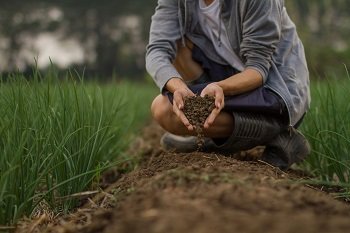
Prepare the soil before planting asparagus to create an optimal growing environment. Remove any weeds, rocks, or debris from the planting area.
Incorporate organic matter such as compost or aged manure to improve soil fertility and drainage.
4. Planting:
Asparagus is typically grown from crowns (year-old asparagus plants). Follow these steps for planting:
A. Dig trenches:
Dig trenches that are 6-8 inches deep and about 12-18 inches wide.
B. Spacing:
Space the crowns approximately 12-18 inches apart within the trenches.
V. Crown Placement:
Place the crowns in the trenches with the buds facing upward.
D. Covering:
Gradually backfill the trenches with soil, covering the crowns with 2-3 inches of soil initially. As the plants grow, continue adding soil until the trench is filled.
5. Watering:
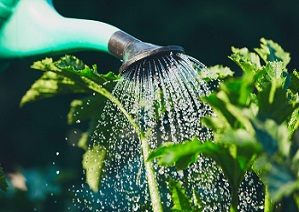
Proper watering is essential for asparagus plants. Water consistently to keep the soil evenly moist, but not waterlogged.
Avoid overwatering, as it can lead to root rot. A deep watering once a week should be sufficient, but adjust according to weather conditions.
6. Fertilizing:
Asparagus plants benefit from regular fertilization to support healthy growth. Apply a balanced fertilizer, such as 10-10-10, in early spring before the spears emerge. Follow the instructions on the fertilizer packaging for the appropriate application rate.
7. Weed Control:
Weeds can compete with asparagus for nutrients and water, so it’s important to control them. Regularly inspect the planting area and remove any weeds by hand or with a shallow cultivation tool. Apply a layer of organic mulch, such as straw or wood chips, to suppress weed growth.
8. Pest and Disease Management:
Asparagus can be susceptible to pests and diseases. Monitor your plants regularly for signs of pests like asparagus beetles or aphids. If detected, employ appropriate organic insecticides or consult with local agricultural extension services for pest management guidance.
Diseases such as rust or crown rot can be managed by practicing good hygiene, removing infected plants, and ensuring proper soil drainage.
Also Read: 12 Tomato Growth Stages Explored: (Complete Life Cycle)
9. Harvesting:
Patience is key when it comes to harvesting asparagus. Avoid harvesting during the first two years to allow the plants to establish a strong root system. In the third year, you can start harvesting spears that are approximately 6-8 inches tall.
Cut the spears at ground level using a sharp knife or scissors. Harvesting should be done regularly, every 2-3 days, during the 6-8 week harvesting period.
How Long Does Asparagus Take to Grow?
Asparagus is a perennial vegetable that takes some time to establish and reach its full production potential. From the time of planting asparagus crowns, it generally takes about 2 to 3 years before you can start harvesting a significant crop. This initial period is crucial for the asparagus plants to develop a strong and healthy root system.
During the first year, it’s important to let the asparagus plants grow without harvesting any spears. This allows the plants to focus on root development and ensures better productivity in the long run.
In the second year, you may be able to harvest a few spears, but it’s still recommended to limit the harvest to allow the plants to continue growing and strengthening.
By the third year, the asparagus plants should be well-established, and you can expect a more substantial harvest. At this stage, you can start harvesting spears that are around 6-8 inches tall and continue to do so for a period of 6-8 weeks.
Remember, asparagus is a perennial crop, and with proper care and maintenance, your asparagus bed can provide you with a bountiful harvest for many years to come.
Several Problems in Asparagus:
Pests:
- Asparagus Beetle: These beetles feed on asparagus foliage and can cause significant damage if left untreated. They lay eggs on the plants, and the larvae also feed on the foliage.
- Cutworms: These pests cut through the asparagus stems at or below the soil level, causing severe damage to the plants.
- Slugs and Snails: These slimy creatures can chew on asparagus foliage, leading to holes and damage to the plants.
- Aphids: Aphids are small insects that suck the sap from asparagus plants, causing stunted growth and deformation of foliage.
- Wireworms: Wireworms are the larvae of click beetles and can damage the roots of asparagus plants, leading to reduced vigor and yield.
Diseases:
- Fusarium Crown and Root Rot: This fungal disease affects the crowns and roots of asparagus plants, causing wilting, stunting, and yellowing of foliage. Infected plants may eventually die.
- Rust: Rust is a fungal disease characterized by rusty brown spots on asparagus foliage. It can weaken the plants and reduce yields.
- Phytophthora Root Rot: This soil-borne pathogen causes root rot in asparagus plants. Affected plants exhibit stunted growth, yellowing, and eventual death.
- Purple Spot: Purple spot is a fungal disease that results in purple-brown lesions on asparagus spears, which can render them unmarketable.
- Cercospora Leaf Spot: Cercospora fungus causes brown, irregularly shaped lesions on asparagus foliage, leading to defoliation and reduced plant vigor.
Many of these problems can be prevented and managed with proper cultural practices, such as maintaining good hygiene, providing adequate nutrition, and rotating crops. In severe cases, insecticides or fungicides may be necessary, but you should consult with local extension services or experts for specific guidance on pest and disease management in your area.
FAQs About Asparagus Growth
1. How long does it take for asparagus seeds to germinate?
Asparagus seeds typically take around two to three weeks to germinate under suitable conditions.
2. Can I grow asparagus in containers?
Yes, you can grow asparagus in containers as long as the containers are deep enough to accommodate the long roots.
3. How many years does it take for asparagus plants to reach the harvesting stage?
Asparagus plants usually take two to three years to reach the harvesting stage, depending on the variety and growing conditions.
4. How often should I harvest asparagus spears?
During the harvesting season, you can harvest asparagus spears every two to three days, depending on their growth rate.
5. What should I do during the asparagus plant’s dormancy period?
During the dormancy period, it is essential to clean up the asparagus bed, remove dead foliage, and provide winter protection if needed.
Conclusion
Understanding the different stages of asparagus growth is vital for successful cultivation. From germination to the dormant phase, each stage plays a crucial role in the plant’s development.
By providing the right conditions, nutrients, and care at each stage, you can ensure a bountiful asparagus harvest. Remember to be patient, as asparagus plants take time to mature and establish a strong root system. So, embrace the journey of growing asparagus and enjoy the fruits of your labor!
Other Growth Stages Articles:
